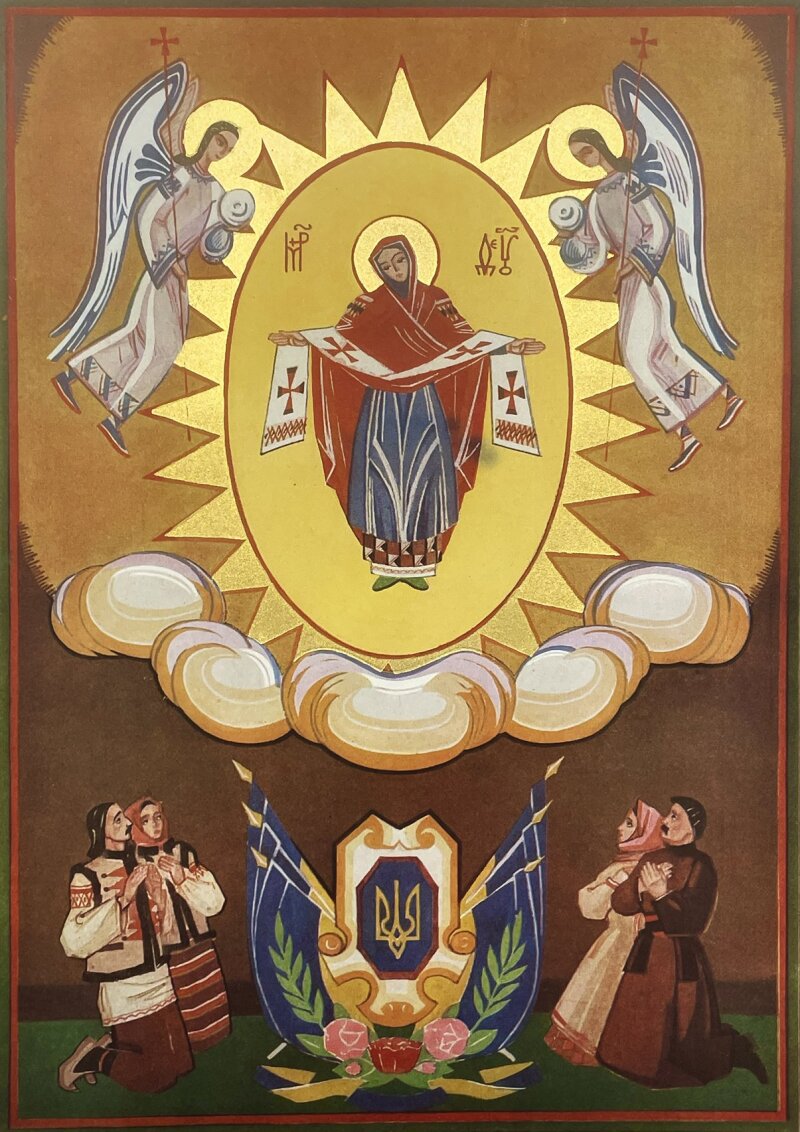
CENTURIES-OLD MARIAN ICON OFFERS SOLACE, PROTECTION AMID HORROR OF WAR
Christina Lee Knauss/Catholic News Service
03/04/2022
As Ukrainians turn to their faith amid the ongoing tragedy of Russia's invasion of their nation, many who follow both the Orthodox and Catholic traditions will look to an unusual icon of Mary as a symbol of the solace they seek.

also called The Holy Pokrov. CNS photo/courtesy
Marian Library, University of Dayton
In some news photos, clergy are seen holding the icon, which depicts Mary holding a long piece of fabric in her outstretched hands.
This sacred image is known in Ukraine and many other East European nations as the "Pokrova," or the Intercession of the Theotokos, "mother of God" in Greek, a title for Mary used in both Eastern Orthodox and Byzantine Catholic churches.
The Pokrov icon has its origins in a 10th-century Marian apparition that occurred in Constantinople, according to Sarah Cahalan, director of the Marian Library at the University of Dayton in Ohio.
Orthodox tradition states that on Oct. 1 in the year 911, Mary appeared to St. Andrew the Fool for Christ during a vigil held at the city's Church of St. Mary of Blachernae Church.
The saint said he saw Mary spreading her cloak — some accounts say it was her veil — over the congregation as a symbol of her protection. At the time the city was under attack and according to tradition, after Mary's appearance the attacking armies withdrew.
After the Pokrov apparition, the image of Mary holding her veil or cloak became associated with protection from war and natural disasters among Eastern Christians, and Prince Yaroslav the Wise placed Ukraine and its people under the protection of the Pokrov in 1037.
Cahalan noted the Pokrova is one of many Marian icons significant to Ukrainian Christians, both Catholic and Orthodox.
Devotion to Mary is an intrinsic part of both Orthodox and Catholic spirituality in the Ukraine, according to Father Silviu Bunta, an Orthodox priest from Romania and professor of Scripture at the University of Dayton.
He said churches of the Orthodox Church, the most common form of Christianity in Ukraine, have many titles for Mary, ranging from "Theotokos" to protectress and champion for people on earth.
"We Orthodox call her by many titles, including 'More Honorable than the Cherubim' because to us, she is the greatest person who ever lived and will ever live," Father Bunta told Catholic News Service.
.JPG)
This is an icon of Mary by Yulian Volyanyuk.
CNS photo/courtesy Marian Library, University of Dayton
"She's the ultimate mediator for us in times of trouble because she was 100% human like we are and now can mediate for us in the heavens," he said. "We in the Orthodox Church would immediately go to her in any time of distress."
Father Bunta said the Pokrov icon can often be seen on display in both Orthodox and Byzantine Catholic churches, and Orthodox churches throughout Eastern Europe celebrate a feast day associated with it on Oct. 1, with special prayer services and processions.
The Pokrova icon, because of its origin in a time of siege and war, would be a natural one for Ukrainians to contemplate during this difficult time, Father Bunta said.
He said the icon would likely also be on display at any Orthodox or Catholic churches in the nation that might offer a special Eastern-rite service for people in crisis and distress called a "Service of Paraklesis."
Cahalan said the Pokrova is just one example of devotion to Mary in a country or culture after she has intervened during a time of strife. She noted that during World War II, there were accounts of Greek soldiers who reported seeing Mary holding a protective veil, an echo of the Pokrov apparition.
When immediate victory is not possible, Mary also is a vital source of solace and hope for those who are suffering, partly because she experienced so much suffering during her own life in having to experience the persecution and crucifixion of her Son.
"She offers protection and, when protection is not possible, she offers comfort to the persecuted and the marginalized," Cahalan said.
As examples, she described photos in the library's collection of rosaries confiscated from migrants at the border between the U.S. and Mexico, who had carried them in order to have a source of prayer and a sign of their faith as they traveled.
She also mentioned the apparitions of Mary at Kibeho, Rwanda, which many of the faithful believe predicted the genocide that tore apart that nation in the 1990s and since has become an important devotion for Catholics who are part of the Rwandan diaspora.
Cahalan said devotion to Mary is one of the important bridges that can help overcome differences between the Orthodox and Catholic faiths.
"Mary, with the Pokrova icon as one example, does offer some possibility for shared ground," she said. "I believe her love and protection is plentiful enough for all of us."
Mary is a comforter in difficult times because she is both an intercessor and has a perspective on our human struggles because she lived life on earth and experienced the same struggles, Father Bunta said.
"We should turn to her not just as someone who intervenes, but also someone who has lived our life," he said. "Mary lived here on earth and has carried God in her womb, and because of that she contains everything in our lives.
"Even when we have a sense of abandonment, estrangement and hopelessness, we can turn to her because through her life she has contained everything and can offer comfort like no one else."
-
